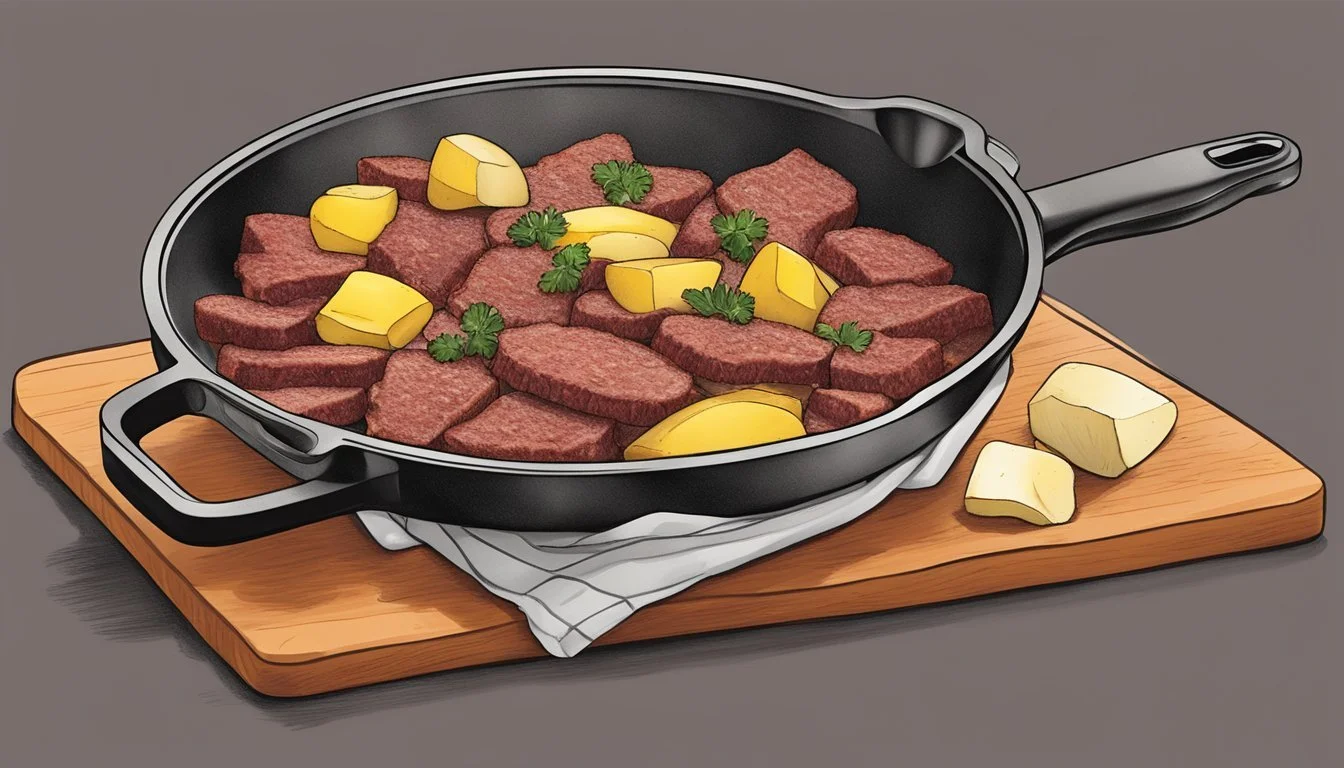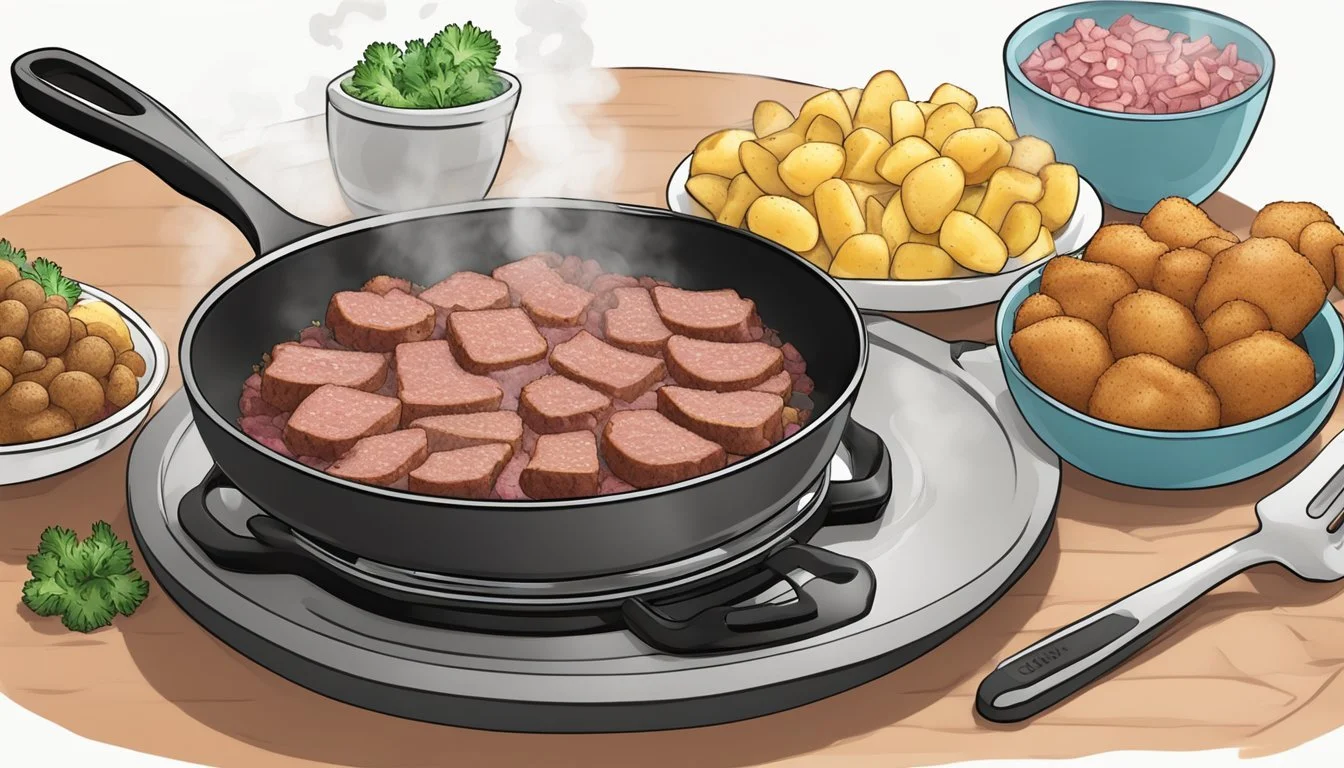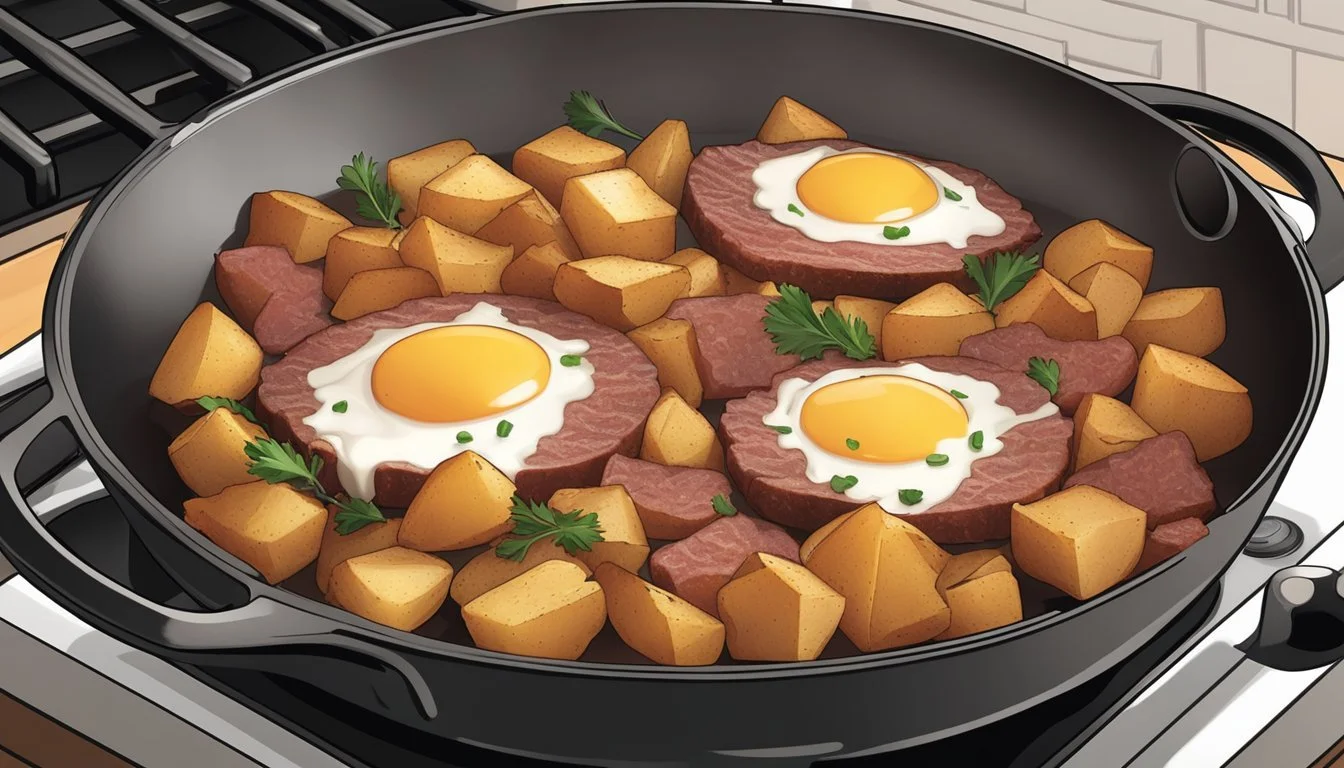Best Way to Reheat Corned Beef Hash
Ensuring Crispy Potatoes and Tender Meat
Corned beef hash makes for a delightful meal with its savory blend of tender corned beef and crispy potatoes. When it comes to reheating leftovers, the challenge is to restore the hash to its original texture and flavor. The best way to reheat corned beef hash is to strike the perfect balance between maintaining the crispness of the potatoes and ensuring the corned beef remains tender.
Oven reheating is an effective method for corned beef hash, as it helps preserve the texture of both the potatoes and the meat. By spreading the hash in an even layer on an oven-safe dish and covering it with foil, the hash rehydrates while the potatoes reacquire their signature crispiness once the foil is removed near the end of reheating.
Another method that suits those who prefer a quick and less hands-on approach is using an air fryer. This appliance is adept at reheating corned beef hash while keeping the potatoes crisp and the beef juicy. By arranging the hash in a single layer and reheating at a moderate temperature, the air fryer revives the meal efficiently. The speed of the air fryer not only saves time but also uses less energy than heating up a traditional oven.
Understanding Corned Beef Hash
Corned beef hash is a hearty dish commonly made from a blend of diced corned beef, potatoes, and spices. It's treasured for its balanced mix of textures and flavors, with variations often stemming from leftover ingredients.
Components of Corned Beef Hash
Corned Beef: The star ingredient, it's typically made from brisket that has been salt-cured and cooked until tender.
Potatoes: Often diced or shredded, they provide heft and a crispy contrast when pan-fried.
Moisture: A small amount of moisture is key to keeping the hash from drying out without becoming soggy.
Seasoning: Garlic, black pepper, and sometimes parsley are used to enhance the savory notes.
Texture and Flavor Profiles
Texture: The optimal hash has a delicate balance where the meat remains tender and the potatoes develop a crisp edge.
Flavor: The seasoning blend aims to complement the robustness of the corned beef and the earthiness of the potatoes.
By focusing on these specifics, one can ensure the integrity of corned beef hash is maintained during reheating.
Preparing for Reheating
To ensure the potatoes remain crispy and the corned beef tender upon reheating, one must follow specific storage and preparation steps. These practices are key to maintaining the quality and safety of the leftover corned beef hash.
Storing Leftovers
Proper storage of corned beef hash is crucial for quality reheating. Leftovers should be cooled to room temperature promptly and stored in an airtight container to prevent contaminants and moisture loss. If the hash will be consumed within three to four days, place it in the refrigerator; otherwise, wrap it tightly with foil or plastic wrap, then place in an airtight container or freezer bag for freezing. When freezing, one should note:
Air Removal: Expel as much air as possible from freezer bags to avoid freezer burn.
Portioning: Divide into portion sizes for easy thawing and reheating.
Storage Location Maximum Storage Time Refrigerator 3-4 days Freezer 2-3 months
Pre-Reheating Best Practices
Before reheating, one should bring the frozen corned beef hash to the refrigerator to allow for gradual and even thawing, ideally overnight. It's important to avoid direct heat as it can dry out the hash. When the dish is nearly at room temperature, it can be reheated more evenly. Covering the corned beef hash with aluminum foil during reheating can also aid in keeping moisture intact, and using a food thermometer is advisable to ensure it reaches a safe internal temperature of 165°F. Here are some steps to prepare:
Thaw frozen corned beef in the refrigerator if needed.
Allow refrigerated hash to sit at room temperature for 15-20 minutes pre-reheating.
Check the hash with a food thermometer after reheating to ensure food safety.
Reheating Methods Overview
When one seeks to reheat corned beef hash successfully, the overarching goal is to maintain the tenderness of the corned beef and the crispiness of the potatoes. Achieving this balance hinges on the method chosen, each with its advantages and tradeoffs.
Pros and Cons: Oven vs. Skillet vs. Microwave
Oven Method:
Pros:
Delivers even heating, preserving the texture.
Hands-off reheating process.
Cons:
Takes longer to preheat and reheat.
May not keep the potatoes as crispy as other methods.
Skillet (Stovetop) Method:
Pros:
Offers quick and controlled reheating.
Skillet can crisp potatoes effectively.
Cons:
Requires constant attention to avoid burning.
Not suitable for large batches unless a large skillet is used.
Microwave Method:
Pros:
Fastest method for reheating.
Useful for small servings or a quick meal.
Cons:
Can make the beef tough and the potatoes soggy.
Less uniform heat distribution.
Each method serves different needs—while the oven can handle larger batches and retains moisture well, the skillet caters to those desiring a crisper outcome. Conversely, the microwave is a quick solution but often at the cost of texture. The method chosen should align with one's priority on texture versus convenience.
Step-by-Step Reheating Use Cases
Ensuring the potatoes in corned beef hash remain crispy while keeping the corned beef tender is key during reheating. The following subsections provide specific instructions on how best to reheat using various kitchen appliances.
Oven Reheating Instructions
To reheat corned beef hash in the oven:
Preheat the oven to 350°F.
Spread the hash in a thin layer on a baking sheet — ideally on top of a piece of foil or parchment paper for easy cleanup.
Lightly drizzle with oil to prevent drying out, ensuring even coating.
Cover with foil for part of the reheating time to keep moisture in.
Total reheating time should be about 10-15 minutes; remove the foil after 7 minutes for a crispier finish.
Skillet Reheating Guidelines
For a skillet approach:
Heat a skillet on the stove over medium heat.
Add a small amount of oil or butter to the skillet to help crisp the potatoes.
Once hot, spread the corned beef hash evenly in the skillet.
Use a lid initially to promote even heating without losing moisture.
After a few minutes, remove the lid and continue to cook until the desired crispiness is achieved, flipping occasionally.
Total time on the stovetop should be around 5-10 minutes to avoid overheating.
Microwave Reheating Tips
When using a microwave:
Place the hash in a microwave-safe dish.
Add a tablespoon of water or stock to the dish to keep everything moist, and cover with a microwave-safe lid or wrap to trap steam.
Heat on medium power in 30-second increments, stirring in between to promote even heating.
Be careful not to overdo it as microwaves can unevenly cook and may make the potatoes soggy. Total microwave time should not exceed 2-3 minutes.
Enhancing Reheating Outcomes
When reheating corned beef hash, the challenge lies in maintaining the crispiness of the potatoes while keeping the corned beef tender. This section addresses strategies for elevating flavor through additional seasoning, as well as practical tips to sidestep common reheating blunders.
Additional Seasoning and Accompaniments
To boost flavor and texture during the reheating process, one may sprinkle the hash with herbs and spices that complement the existing seasoning. For instance:
Herbs: Fresh herbs like parsley or thyme can be added after reheating to enhance freshness.
Spices: A pinch of paprika or garlic powder may accentuate the meat's savoriness.
Accompaniments can also play a role in texture and flavor enhancement. Consider serving the reheated hash with:
Sauces: A dollop of horseradish or mustard can introduce a tangy kick.
Textures: Serving with a crispy salad can balance the richness of the hash.
Avoiding Common Reheating Mistakes
When attempting to preserve moisture and texture:
Moisture: Covering the hash with a damp paper towel during microwaving can help retain moisture without making the potatoes soggy.
Texture: To prevent texture loss, avoid overcooking as it can toughen the meat.
Cutting: Slicing the corned beef against the grain can ensure tenderness.
Reheating tips to minimize the risk of bacterial growth and drying out include:
Steaming: If using a water bath or steaming, ensure the meat is not submerged, which can make it soggy.
Air Frying: For air frying, reheating at a lower temperature can prevent the exterior from drying while maintaining internal moisture.
By taking these practical steps, one can adeptly enhance the flavor and texture outcomes of reheated corned beef hash.
Serving and Presentation
When it comes to serving reheated corned beef hash, it's crucial to maintain the contrasting textures of crispy potatoes and tender corned beef. A thoughtful presentation enhances the dining experience, whether it's a cozy family breakfast or a St. Patrick’s Day feast.
Pairing with Sides and Sauces
For a more satisfying and hearty meal, corned beef hash can be accompanied by a variety of sides and sauces. Some top selections include:
Fried eggs: A classic addition, place a runny-yolk fried egg atop the hash for a rich and creamy component.
Roasted vegetables: Serve with roasted carrots or cabbage for a touch of sweetness and a nod to Irish culinary traditions.
Irish Potato and Corned Beef Cakes or Croquettes: Use leftovers to create these, serving as an appetizer or a side.
Bread: Offer slices of crusty bread to sop up the flavorsome mingling of beef and potatoes.
Sauces to drizzle or dip:
Parsley sauce: A light herby sauce that compliments the corned beef without overpowering.
Horseradish cream: For those preferring a kick, this sauce adds a spicy contrast to the dish.
Creative Leftover Transformations
Transform cold corned beef hash leftovers into a new meal with simple yet inventive ideas:
Sandwiches: Incorporate reheated sliced corned beef and crispy hash as a robust filling between two slices of bread.
Brunch (What wine goes well with brunch?) Staple: Feature the hash as a star player in a brunch spread, perfect for the morning after a St. Patrick’s Day celebration.
Always ensure that the corned beef hash is reheated until piping hot to guarantee food safety, and serve immediately for optimal taste and texture.
Safe Food Handling Practices
When reheating corned beef hash to maintain the crispiness of potatoes and tenderness of the beef, it is imperative to adhere to safe food handling practices. These include understanding the safe internal temperatures necessary to eliminate bacteria and implementing best practices to prevent foodborne illness.
Understanding Safe Internal Temperatures
The safe internal temperature for reheated corned beef is 165°F as measured with a food thermometer. An instant-read thermometer can provide an accurate reading and is essential for confirming that the beef has reached the temperature necessary to kill harmful bacteria.
Beef: 165°F
Using a food thermometer not only ensures safety but also helps in preventing overcooking, which can lead to dryness.
Best Practices to Prevent Foodborne Illness
To prevent foodborne illness while reheating corned beef hash, one should:
Thoroughly Wash Hands: Before and after handling corned beef, wash hands with soap and water for at least 20 seconds.
Avoid Cross-Contamination: Use separate cutting boards and utensils for cooked and raw foods.
Store Correctly: Keep leftovers in the refrigerator within two hours of cooking, stored in airtight containers.
Reheat Properly: Ensure that the hash reaches the internal temperature of 165°F throughout to effectively eliminate any present bacteria.
These practices help maintain food safety and prevent the introduction and proliferation of bacteria that can cause illness.
Expert Tips and Tricks
To reheat corned beef hash for a crispy potato texture and tender meat, there are professional techniques for perfect results and best practices for storage and reheating that maintain quality.
Professional Chefs’ Advice for Perfect Reheating
Oven Method:
Preheat oven to 350°F (175°C).
Spread hash in a single layer on an oven-safe dish or baking sheet lined with parchment paper.
Use aluminum foil to cover lightly, ensuring the moisture is retained.
Bake for 15-20 minutes, checking periodically with an instant-read thermometer for an internal temperature of 165°F.
Skillet Method:
Heat a skillet over a medium-low flame.
Add a pat of butter or oil to enhance flavor.
Reheat hash in a single layer for crispiness.
Add a splash of stock or water to keep the beef tender.
Cover with a lid, steam for a few minutes, stirring occasionally.
Long-Term Storage and Reheating Plans
Storage:
Place cooled hash in an airtight container.
Store in the refrigerator; consume within three to four days.
Reheat from Refrigerated: Oven:
Preheat to 350°F; heat covered with foil to prevent drying out.
Skillet:
Stir frequently on medium-low heat with a dash of liquid.
Microwave:
Use a microwave-safe plate, cover with a damp paper towel to maintain moisture.
Heat in 30-second intervals, stirring in between.
Air-Fryer:
Heat at 350°F for a few minutes until desired warmth and crispiness.
From Frozen:
Thaw in the refrigerator overnight.
Follow reheating steps above, possibly increasing time slightly to ensure thorough warming.






